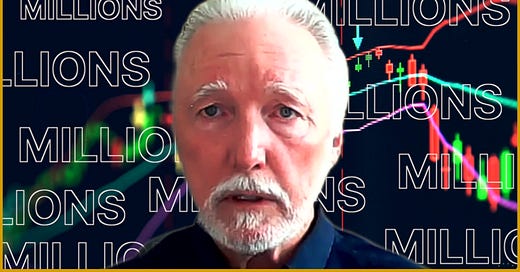James West: Well, hey everybody, welcome back. My next guest is Malcolm Bell. He's the CEO of Pacific Minerals, trading on the CSC under the symbol NVPC and in the United States under the symbol NVPCF. Malcolm, welcome.
Malcolm, you are working on one of the most interesting, fascinating deposits in Canada, as far as I'm concerned. And I can say that with a degree of authority because I've been following this story since 2012. You're developing the Lara Project, which, correct me if I'm wrong, has some really impressive grades in copper, silver, zinc, and gold.
Malcolm Bell: Oh my God, yeah, it's off the charts at surface. I think we've got an intact, what we call an H black smoker at surface, which is running 45% zinc, 7 ounces per ton gold, 5% copper, and 460 grams of silver. And there are many zones like that in the deposit.
James West: Wow. So these are historical press-released drill results you're talking about?
Malcolm Bell: Yeah, that's right. And this is in a volcanogenic massive sulfide system.
James West: Give us an overview. How is that important to the context of the geological setting? What's the history of VMS deposits in the world's mining value?
Malcolm Bell: Well, that's a good question. But I can give you an example of a mine that's just up the geological structure from where we're sitting. It's the fifth-largest polymetallic deposit in Canada—called the Myra Falls deposit. It contains zinc, copper, gold, silver, and lead in the exact same proportions as we have on our project. Now, Myra Falls is the most important massive sulfide deposit in western Canada. Our project is what I would call the daughter of Myra Falls. They started with 2 million tons and, over 40 years, continued to find more ore. We have 2 million tons in our project, and when it was discovered, the operators focused entirely on the main zone. Over eight years, they drilled over 350 drill holes to outline it and even went underground with a decline and pre-production access. We have the benefit of about $30 million worth of exploration already completed.
James West: So your plan isn’t necessarily to continue exploring at the expense of shareholders but rather to start mining and producing ore, correct? And you’re not milling it?
Malcolm Bell: That’s right. There’s no milling circuit involved. It’s a very clean operation. There will be no tailings ponds either. We mine 500 tons a day, bring it to the surface, crush the ore, and then put it through an optical ore sorter. This technology, developed over the last 10 years, uses high-speed computers, XRF, and laser technology to separate ore from waste rock. The waste drops away, while the ore above the cutoff grade is retained, packed into large sacks, and shipped directly from the end of the conveyor belt.
James West: So you're mining 500 tons a day, processing 500 tons a day, and doing this 360 days a year? And the mine life is currently estimated at 10 years?
Malcolm Bell: That’s right. We don’t really have to do any more exploration. But this project is going to throw off a lot of cash—millions and multi-millions of dollars. From that, we’ll continue exploration. We have numerous targets left to explore. This deposit is open along strike and at depth. We have about 8 kilometers of strike, and because VMS deposits occur in clusters, we expect to discover more as we continue exploring.
James West: When does all this mining get started?
Malcolm Bell: We have a drill permit in right now to confirm the original grades and tonnage estimates, as well as generate additional ore. That project should start around the first of March. We’ll complete it in about two and a half months, drilling 24 hours a day with two drill rigs. By September, we’ll have a new mineral resource estimate and will apply for a mining permit. That should take 12 to 18 months.
James West: So this will start producing cash flow next year?
Malcolm Bell: That’s correct.
James West: That’s record speed for a mining project, though this one has been in exploration for over 20 years.
Malcolm Bell: Yes, the original plan was to put it into production in 1992, but metal prices were too low. They kept it on care and maintenance. Then in 2022, during COVID, geologists working from home forgot to file assessment work, and the property became available for staking. A prospector in Vancouver Island staked it, and I was able to acquire it through my connections. Finding a project like this is rare. It’s not in remote northern British Columbia—we have high-speed logging access, power across the property, and we’re only 14 kilometers from a port. It’s a low-cost exploration program.
James West: And it's all funded through mining revenue?
Malcolm Bell: Yes. Future exploration and our capex—somewhere between $50-75 million—will be funded internally, avoiding dilution.
James West: What are the chances Lara turns out to be as big as Myra Falls?
Malcolm Bell: There’s a good chance. Some PhDs I work with believe deeper drilling could reveal a 40-million-ton deposit. VMS deposits tend to increase in grade and size at depth.
James West: That’s incredible. Any environmental concerns?
Malcolm Bell: No tailings ponds, no chemical processing. A 2012 environmental impact study found no issues. We also have strong relations with First Nations and are committed to reconciliation.
James West: And in terms of funding?
Malcolm Bell: We’re fully funded for our 10,000-meter drill program, which is flow-through funded. If needed, we could raise a small financing at higher prices.
James West: It all sounds so good. What keeps you up at night?
Malcolm Bell: We don’t have a major concern yet, but experienced management always anticipates challenges. With 50 years in mineral exploration, I trust our ability to navigate any issues.
James West: Fantastic, Malcolm. We’ll leave it there. Best of luck!
Malcolm Bell: Thanks, James!








Share this post